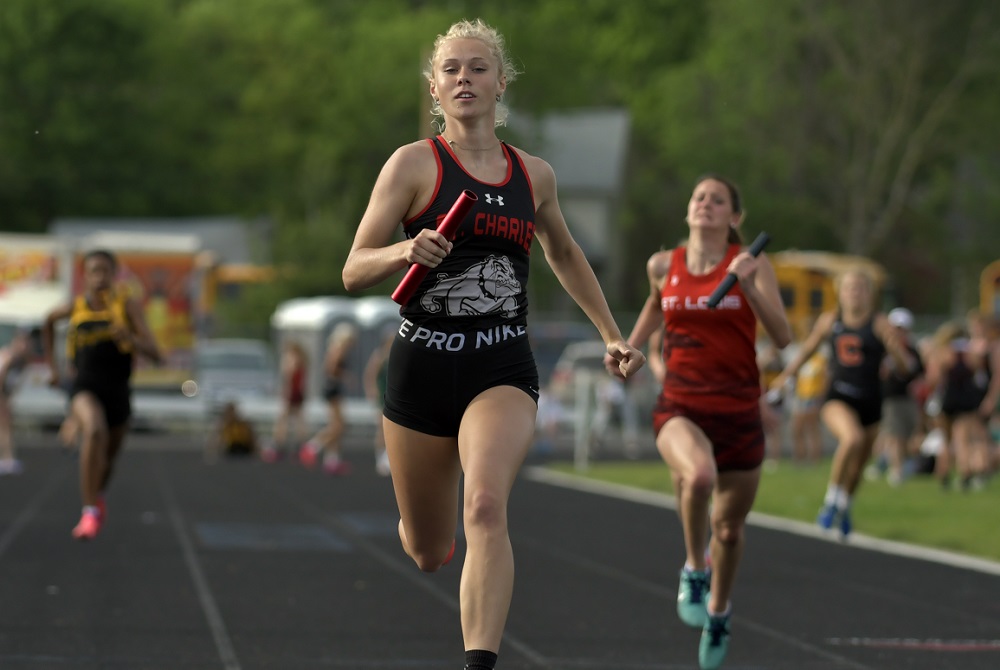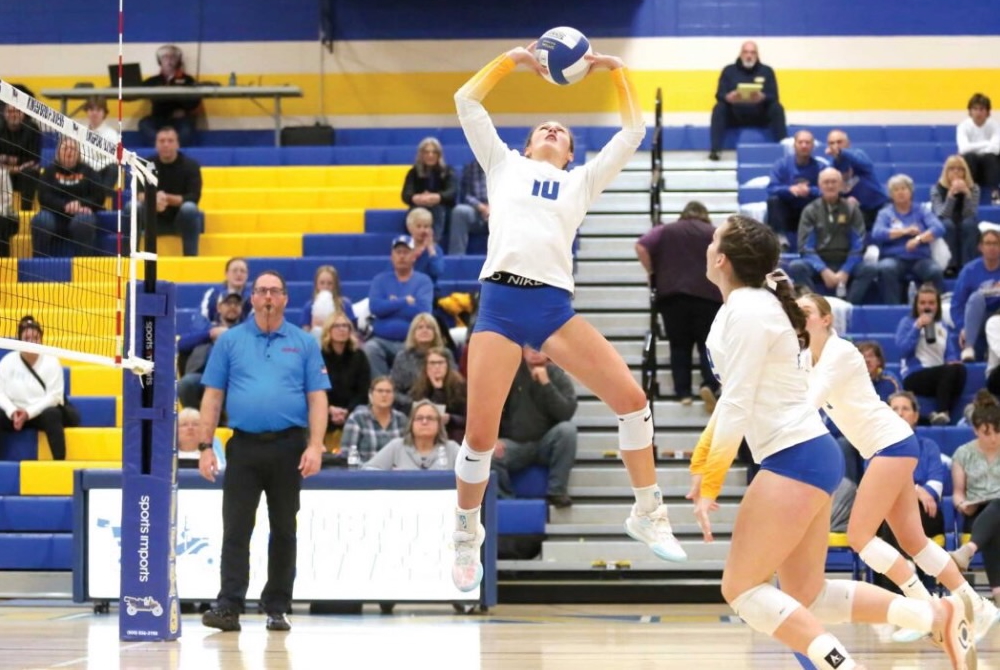
Preview: Restart Could Reveal New LP Girls Contenders
By
Geoff Kimmerly
MHSAA.com senior editor
June 4, 2021
A year away because of COVID-19 makes anticipating champions at Saturday’s Lower Peninsula Girls Track & Field Finals even more difficult than usual.
Of course, frequent favorite Oak Park is back in Division 1 and is almost assured of being in that title mix with a few more speedy teams including Detroit Renaissance. But as for the other three divisions? There are plenty of possibilities, including teams that haven’t been in the conversation much before.
Events begin at 10 a.m. (EDT) and tickets to attend can be purchased online only at GoFan. The meets also will be broadcast on MHSAA.tv and viewable with subscription. Click to watch each division: LPD1 | LPD2 | LPD3 | LPD4.
Below is a glance at team contenders and individuals to watch in all four divisions.
Division 1 at East Kentwood
Top Regional scores: Northville 164, Macomb Dakota 144, Detroit Cass Tech 143.
Team forecast: Oak Park has won the last two Division 1 championships and four of the last five (finishing runner-up in 2017). The Knights might be the team to chase again with top seeds in four events and two more lower-seeded relay contenders. Detroit Renaissance was runner-up in 2019 and should be in the mix with high finishes in the sprints and sprint relays, while Ann Arbor Huron has contenders all over the running events plus the top-seeded long jumper.
Fatouma Conde, Ann Arbor Huron: If Huron is to make a team title run, Conde most certainly will play one of the largest parts. She’s seeded second in the 100 and 200 and is expected to run on the top-seeded 400 relay (47.46) and second-seeded 1,600 relay.
Audrey DaDamio, Birmingham Seaholm: The Division 1 cross country champion in the fall will be looking to add a few more titles in her final meet for the Maples. She’s seeded first in the 1,600 (4:50.01) – which her sister Rachel won in 2015 – and also in the 3,200 (10:40.72), and she’s the third seed in the 800.
Kaila Jackson, Detroit Renaissance: Jackson made an immediate impact in her Finals debut in 2019 with championships in the 200 and as part of the 800 relay to go with a runner-up finish in the 100. Now a junior, her top-seeded 11.58 in the 100 lines her up to chase the all-Finals record of 11.54, and her top-seeded 23.71 in the 200 is faster than the all-Finals record of 23.74. She’ll also run on the top-seeded 800 relay (1:37.91) and second-seeded 400 relay.
Opal Jackson, Macomb L’Anse Creuse North: The senior thrower is the favorite in both the shot put (47-3) and discus (145-2) with her Regional tosses in those events two and four feet, respectively, farther than the next best in these fields.
Jada Roundtree, Oak Park: One of many Oak Park standouts, Roundtree is the top seed in the 400 (55.47) and will run on the top-seeded 1,600 relay (3:50.9) and second-seeded 800 relay.
Nonah Waldron, Oak Park: Part of the next generation of Oak Park stars, Waldron is a sophomore and seeded first in the 100 hurdles (13.77) and 300 (43.31) at her first Finals. She also will long jump and run on the 800 relay.
Division 2 at Zeeland
Top Regional scores: Dearborn Divine Child 214, Bloomfield Hills Cranbrook Kingswood 134, Chelsea 134.
Team forecast: Six teams have won this meet over the last seven seasons, with Corunna the most recent champ in 2019. A number of teams appear contenders this time, with Divine Child, Petoskey and Parma Western among the intriguing possibilities. Divine Child is running for its first title since 2013 backed by strong relays and qualifiers in a variety of events. Petoskey’s only top-two Finals finish was a Class B runner-up in 1992, but the Northmen could compete for championships in four distance events. Western also has never won a team title but has top-four seeds in six events.
Hannah Antkoviak, Allegan: She finished second in the 300 and fourth in the 100 hurdles in 2019 as a sophomore, and she enters this weekend as the top seed in the 300 (45.16) and long jump (17-2¾) and third in the 100 hurdles.
Madelyn Frens, Grand Rapids Christian: The 3,200 runner-up as a freshman two years ago is the second seed in the 1,600 and third in the 3,200 and was third in Division 2 cross country in the fall.
Chaniya Madison, Bridgeport: The lone returning champion from the 2019 Division 2 meet won the 100 that spring as a freshman and will run that race, the 200 and on the 400 relay this time.
Reese Powers, Marysville: The Vikings standout junior should make a run at two individual championships as the top seed in the 800 (2:18.03) by nearly two seconds and a close second seed in the 400.
Emma Squires, Petoskey: The Division 2 cross country champion this past fall, she posted top-eight finishes in the 1,600 and 3,200 as a sophomore in 2019 and is seeded first in the 1,600 (5:08.52) and second in the 3,200 this time. She’ll also run the 800 and as part of the top-seeded 3,200 relay (9:27.52).
Division 3 at Jenison
Top Regional scores: Clare 180½, Pewamo-Westphalia 161½, Adrian Madison 143, Montague 143.
Team forecast: Pewamo-Westphalia is the reigning champion and has won three of the last seven championships. The Pirates have six top-five seeds this weekend and should be in the mix again especially if the meet is low-scoring. Grass Lake is seeded third or better in all five events in which it will participate, and Adrian Madison and Byron also are intriguing at a meet where individual champions can drive team scoring.
Carly Anschuetz, Adrian Madison: She’s the top seed in the 100 hurdles (15.81) and 300 (47.29) and also will high jump and run on the 800 relay. She was third in the 300 as a sophomore in 2019.
Lexus Bargesser, Grass Lake: The champion in the 100 and 200 two years ago as a freshman is the top seed in the 200 (25.32) and 400 (55.15) and second seed in the 100 this time, and she’ll also run on the top-seeded 1,600 relay (4:08.97).
Allison Chmielewski, Roscommon: The junior distance standout has the top seed in the 1,600 (4:53.68) by nearly 18 seconds with a time only 4.28 seconds off the meet record. She was fourth in both the 1,600 and 3,200 as a freshman and also will run the 800 and on the 3,200 relay this time.
Renae Kutcha, Jackson Lumen Christi: She may be the second seed in the 400, but Kutcha is looking to add her third championship in that race after earning the titles as a freshman and sophomore. She also will run the 200 and as part of the 1,600 relay.
Sarah Marvin, Byron: The champion in both the discus and shot put as a sophomore in 2019 is seeded first in both this weekend at 151-0 and 49-10¾, respectively. That shot put is more than three feet longer than the LPD3 Finals record.
Abby VanderKooi, Muskegon Western Michigan Christian: A three-time Cross Country Finals champion, VanderKooi also claimed the Division 3 3,200 title as a freshman two years ago and is seeded first (10:49.44) in that race this weekend by more than 21 seconds.
Division 4 at Hudsonville Baldwin Middle School
Top Regional scores: Hillsdale Academy 179, Lutheran Westland 149, Allen Park Cabrini 136.
Team forecast: Before COVID, Fowler had won two straight Division 4 titles and three of the last four, with Pittsford the runner-up in both 2018 and 2019. Hillsdale Academy was sixth in 2019 but could make the move for its first team championship with qualifiers all over the lineup and strong relays. Mount Pleasant Sacred Heart also should be a contender for its first championship with lots of points possibilities in the running events.
Olivia Findlay, Marlette: The freshman enters her first Finals with the top seed in the long jump (16-1½) and tied for the top seed in the high jump (5-3). She also will run on the 800 relay.
Ashley Plum, Mount Pleasant Sacred Heart: The Irish senior sprinter is the top seed in the 200 (26.58) and also will run the 100 and 400 and on the top-seeded 1,600 relay (4:14.35). She was part of the winning 1,600 relay in 2019.
Makenna Scott, Maple City Glen Lake: The standout junior is the top seed in the 3,200 (12:03.63) by more than 16 seconds and the second seed in the 1,600 after also running both as a freshman in 2019. She’ll also run on the 1,600 relay.
Tara Townsend, Frankfort: She won the pole vault championship two years ago as a freshman and is the top seed by a foot at 11-0. She’ll also run the 100, 200 and on the 400 relay. She was seventh in the 100 in 2019.
Tess VanDyk, Kalamazoo Christian: The junior thrower is a favorite in both events, entering the weekend with the top-seeded shot put (36-7) and second-seeded discus toss.
PHOTO: St. Charles’ Lindsey Pumford anchors her 400 relay to a Division 3 Regional championship two weeks ago at Shepherd. (Click for more from High School Sports Scene.)

Kingsford's Kreider Prepared for Next Level After Finishing Stellar Flivvers Career
By
John Vrancic
Special for MHSAA.com
June 19, 2025
KINGSFORD — After completing a successful high school volleyball career, Maddy Kreider is ready to take the next step.
 The Kingsford senior is taking her talents to Michigan Tech, where she’s expected to continue primarily as a setter.
The Kingsford senior is taking her talents to Michigan Tech, where she’s expected to continue primarily as a setter.
“That will be a big step for sure, but it’ll be exciting being with the girls,” she said. “The girls are taller in college. It will definitely be an adjustment, physically and mentally. We’ll be traveling longer distances, and it’ll be a matter of improving the mental part of my game.”
Kreider was selected the Upper Peninsula’s Defensive Player of the Year her final two seasons after the U.P. Sportswriters and Sportscasters Association began voting for all-U.P. volleyball.
“That’s quite an accomplishment,” she said. “It’s a real honor playing with girls I grew up with. We had a great season.”
The 5-foot-8 setter was a four-year starter and two-year team captain at Kingsford, leading the Flivvers to three Division 2 District titles and back-to-back undefeated Great Northern Conference championships. She twice was named GNC Player of the Year.
She was also selected all-state first team in the fall and all-state second team in 2023, and all-region throughout her prep career. Her serving percentage also topped .900 throughout her four seasons on varsity.
 Last fall, the Flivvers reached the Regional Semifinal at Manistique where they dropped a 3-2 decision to Kingsley.
Last fall, the Flivvers reached the Regional Semifinal at Manistique where they dropped a 3-2 decision to Kingsley.
“I thought we’d get through,” Kreider said. “We came out lights out in the first two sets, then it was close in the last three.”
Also among the team’s highlights this past fall was a victory at Calumet, approximately 2½ weeks after dropping a 3-1 decision to the Copper Kings on Kingsford’s home floor.
“We wanted to play them,” Kreider said. “They’re a great bunch of girls to play against. They’ve been the measuring stick up here for many years. Winning on their floor was super exciting. We knew we had to play well just to be competitive. That was a great confidence builder for our group. We were definitely on a high going into the District.”
The Flivvers opened their postseason with a 3-1 triumph over Houghton, then defeated Escanaba in straight sets in the District Final.
Kreider will join Calumet senior Maddie Torola at MTU this fall. Torola, who recorded a season-high 19 kills in the four-set victory at Kingsford, helped the Copper Kings finish 29-5 and reach the Division 3 Regional Final at Sault Ste. Marie where they dropped a 3-2 decision to Traverse City St. Francis.
“It was fun playing against her in high school,” Kreider said. “It will be even more fun playing as teammates. It’ll be exciting to be playing on the same team.”
Both will be playing under new head coach Cindy Pindral at Tech. Both of Kreider’s parents played for the Huskies, her mother (and Kingsford varsity coach) Jaclynn volleyball from 1998-2002 and her father Jason basketball from 1997-2000.
Maddy Kreider recently earned an additional honor when she was selected Female Athlete of the Year for Kingsford’s Class of 2025. She recently completed a solid track & field season for the Flivvers.
At the U.P. Division 1 Finals, Kreider placed fourth in the 100-meter dash (13.2) and anchored the Flivvers to a third-place finish in the 800 relay (1:51.57) and fourth in the 400 (53.03) on their home track.
Kreider was named one of 32 MHSAA/Farm Bureau Insurance Scholar-Athlete Award winners this winter and plans to study exercise science and kinesiology at MTU.
 John Vrancic has covered high school sports in the Upper Peninsula since joining the Escanaba Daily Press staff in 1985. He is known most prominently across the peninsula for his extensive coverage of cross country and track & field that frequently appears in newspapers from the Wisconsin border to Lake Huron. He received the James Trethewey Award for Distinguished Service in 2015 from the Upper Peninsula Sportswriters and Sportscasters Association.
John Vrancic has covered high school sports in the Upper Peninsula since joining the Escanaba Daily Press staff in 1985. He is known most prominently across the peninsula for his extensive coverage of cross country and track & field that frequently appears in newspapers from the Wisconsin border to Lake Huron. He received the James Trethewey Award for Distinguished Service in 2015 from the Upper Peninsula Sportswriters and Sportscasters Association.
PHOTOS (Top) Kingsford’s Maddy Kreider sets for her teammates during a match last season. (Middle) Kreider, right, takes a photo with Kingsford’s Male Athlete of the Year Gavin Grondin. (Photos provided by the Kingsford athletic department.)

